Biomass-Derived Advanced Carbon-Based Electrocatalysts for Oxygen Reduction Reaction
Abstract
:1. Introduction
2. Fundamentals of ORR
2.1. Basic Parameters to Evaluate ORR Catalysts
2.1.1. Onset Potential and Half-Wave Potential
2.1.2. Kinetic Current Density
2.1.3. Electron Transfer Number and HO2− Percentage
3. Strategies for Enhancing the ORR Activity of Biomass-Derived Carbonaceous Material
3.1. Modulation of sp2 Carbon via Monoheteroatom/Multiheteroatom Doping for ORR
3.2. Modulation of Porosity
3.2.1. Physical Activation
3.2.2. Chemical Activation
3.2.3. Self-Activation
3.2.4. Template Activation
Hard Template Method
Soft Template Method
4. Biomass-Derived Carbon-Based Materials for ORR
4.1. Carbohydrates and Polysaccharides
4.2. Plant-Based Biomass
5. Chitin and Chitosan-Based Biomass
6. Lignin-Based Biomass
7. Conclusions and Future Perspective
Supplementary Materials
Author Contributions
Funding
Acknowledgments
Conflicts of Interest
References
- Borghei, M.; Lehtonen, J.; Liu, L.; Rojas, O.J. Advanced biomass-derived electrocatalysts for the oxygen reduction reaction. Adv. Mater. 2018, 30, 1703691. [Google Scholar] [CrossRef]
- Jasinski, R. A New Fuel cell cathode catalyst. Nature 1964, 201, 1212–1213. [Google Scholar] [CrossRef]
- Yang, L.; Shui, J.; Du, L.; Shao, Y.; Liu, J.; Dai, L.; Hu, Z. Carbon-based metal-free ORR electrocatalysts for fuel cells: Past, present, and future. Adv. Mater. 2019, 31, 1804799. [Google Scholar] [CrossRef]
- Chen, D.; Li, G.; Chen, X.; Zhang, Q.; Sui, J.; Li, C.; Zhang, Y.; Hu, J.; Yu, J.; Yu, L. Developing nitrogen and Co/Fe/Ni multi-doped carbon nanotubes as high-performance bifunctional catalyst for rechargeable zinc-air battery. J. Colloid Interface Sci. 2021, 593, 204–213. [Google Scholar] [CrossRef]
- Seh, Z.W.; Kibsgaard, J.; Dickens, C.F.; Chorkendorff, I.B.; Nørskov, J.K.; Jaramillo, T.F. Combining theory and experiment in electrocatalysis: Insights into materials design. Science 2017, 355, eaad4998. [Google Scholar] [CrossRef]
- Doan, T.L.L.; Tran, D.T.; Nguyen, D.C.; Kim, D.H.; Kim, N.H.; Lee, J.H. Rational engineering CoxOy nanosheets via phosphorous and sulfur dual-coupling for enhancing water splitting and Zn–air battery. Adv. Funct. Mater. 2021, 31, 2007822. [Google Scholar] [CrossRef]
- Cui, Z.; Fu, G.; Li, Y.; Goodenough, J.B. Ni3FeN-Supported Fe3Pt intermetallic nano alloy as a high-performance bifunctional catalyst for metal-air batteries. Angew Chem. Int. Ed. 2017, 56, 9901–9905. [Google Scholar] [CrossRef]
- Li, H.; Li, Q.; Wen, P.; Williams, T.B.; Adhikari, S.; Dun, C.; Lu, C.; Itanze, D.; Jiang, L.; Carroll, D.L. Colloidal cobalt phosphide nanocrystals as trifunctional electrocatalysts for overall water splitting powered by a zinc-air battery. Adv. Mater. 2018, 30, 1705796. [Google Scholar] [CrossRef]
- Huang, S.-J.; Muneeb, A.; Sabhapathy, P.; Sheelam, A.; Bayikadi, K.S.; Sankar, R. Tailoring the Co 4+/Co 3+ active sites in a single perovskite as a bifunctional catalyst for the oxygen electrode reactions. Dalton Trans. 2021, 50, 7212–7222. [Google Scholar] [CrossRef]
- Shi, X.; Ling, X.; Li, L.; Zhong, C.; Deng, Y.; Han, X.; Hu, W. Nanosheets assembled into nickel sulfide nanospheres with enriched Ni3+ active sites for efficient water-splitting and zinc–air batteries. J. Mater. Chem. A 2019, 7, 23787–23793. [Google Scholar] [CrossRef]
- Wang, Y.; Li, J.; Wei, Z. Recent progress of carbon-based materials in oxygen reduction reaction catalysis. ChemElectroChem 2018, 5, 1764–1774. [Google Scholar] [CrossRef]
- Dhyani, V.; Bhaskar, T. A Comprehensive review on the pyrolysis of lignocellulosic biomass. Renew. Energy 2018, 129, 695–716. [Google Scholar] [CrossRef]
- Wang, J.; Nie, P.; Ding, B.; Dong, S.; Hao, X.; Dou, H.; Zhang, X. Biomass derived carbon for energy storage devices. J. Mater. Chem. A 2017, 5, 2411–2428. [Google Scholar] [CrossRef]
- Saini, S.; Chand, P.; Joshi, A. Biomass derived carbon for supercapacitor applications. J. Energy Storage 2021, 39, 102646. [Google Scholar] [CrossRef]
- Chakraborty, R.; Vilya, K.; Pradhan, M.; Nayak, A.K. Recent advancement of biomass-derived porous carbon based materials for energy and environmental remediation applications. J. Mater. Chem. A 2022, 10, 6965–7005. [Google Scholar] [CrossRef]
- Wei, Q.; Cherif, M.; Zhang, G.; Almesrati, A.; Chen, J.; Wu, M.; Komba, N.; Hu, Y.; Regier, T.; Sham, T.-K.; et al. Transforming reed waste into a highly active metal-free catalyst for oxygen reduction reaction. Nano Energy 2019, 62, 700–708. [Google Scholar] [CrossRef]
- Kaur, P.; Verma, G.; Sekhon, S.S. Biomass derived hierarchical porous carbon materials as oxygen reduction reaction electrocatalysts in fuel cells. Prog. Mater. Sci. 2018, 102, 1–71. [Google Scholar] [CrossRef]
- Gao, S.; Fan, H.; Zhang, S. Nitrogen-enriched carbon from bamboo fungus with superior oxygen reduction reaction activity. J. Mater. Chem. A 2014, 2, 18263–18270. [Google Scholar] [CrossRef]
- Wang, N.; Li, T.; Song, Y.; Liu, J.; Wang, F. Metal-free nitrogen-doped porous carbons derived from pomelo peel treated by hypersaline environments for oxygen reduction reaction. Carbon 2018, 130, 692–700. [Google Scholar] [CrossRef]
- Liu, L.; Zeng, G.; Chen, J.; Bi, L.; Dai, L.; Wen, Z. N-Doped porous carbon nanosheets as pH-universal ORR electrocatalyst in various fuel cell devices. Nano Energy 2018, 49, 393–402. [Google Scholar] [CrossRef]
- Huang, B.; Liu, Y.; Guo, Q.; Fang, Y.; Titirici, M.-M.; Wang, X.; Xie, Z. Porous carbon nanosheets from biological nucleobase precursor as efficient pH-independent oxygen reduction electrocatalyst. Carbon 2020, 156, 179–186. [Google Scholar] [CrossRef]
- Ghosh, S.; Santhosh, R.; Jeniffer, S.; Raghavan, V.; Jacob, G.; Nanaji, K.; Kollu, P.; Jeong, S.K.; Grace, A.N. Natural biomass derived hard carbon and activated carbons as electrochemical supercapacitor electrodes. Sci. Rep. 2019, 9, 1–15. [Google Scholar] [CrossRef]
- Zhao, J.; Liu, Y.; Quan, X.; Chen, S.; Yu, H.; Zhao, H. Nitrogen-doped carbon with a high degree of graphitization derived from biomass as high-performance electrocatalyst for oxygen reduction reaction. Appl. Surf. Sci. 2017, 396, 986–993. [Google Scholar] [CrossRef]
- Machan, C.W. Advances in the molecular catalysis of dioxygen reduction. ACS Catal. 2020, 10, 2640–2655. [Google Scholar] [CrossRef]
- Katsounaros, I.; Cherevko, S.; Zeradjanin, A.R.; Mayrhofer, K.J.J. Oxygen electrochemistry as a cornerstone for sustainable energy conversion. Angew. Chem. Int. Ed. 2014, 53, 102–121. [Google Scholar] [CrossRef]
- Rao, M.L.; Damjanovic, A.; Bockris, J.O. Oxygen adsorption related to the unpaired d-electrons in transition metals. J. Phys. Chem. 1963, 67, 2508–2509. [Google Scholar] [CrossRef]
- Nørskov, J.K.; Rossmeisl, J.; Logadottir, A.; Lindqvist, L.; Kitchin, J.R.; Bligaard, T.; Jonsson, H. Origin of the overpotential for oxygen reduction at a fuel-cell cathode. J. Phys. Chem. B 2004, 108, 17886–17892. [Google Scholar] [CrossRef]
- Worku, A.K.; Ayele, D.W.; Habtu, N.G. Recent advances and future perspectives in engineering of bifunctional electrocatalysts for rechargeable zinc–air batteries. Mater. Today Adv. 2021, 9, 100116. [Google Scholar] [CrossRef]
- Lee, B.; Seo, H.R.; Lee, H.R.; Yoon, C.S.; Kim, J.H.; Chung, K.Y.; Cho, B.W.; Oh, S.H. Critical role of pH evolution of electrolyte in the reaction mechanism for rechargeable zinc batteries. ChemSusChem 2016, 9, 2948–2956. [Google Scholar] [CrossRef]
- Ginting, R.T.; Ovhal, M.M.; Kang, J.-W. A novel design of hybrid transparent electrodes for high performance and ultra-flexible bifunctional electrochromic-supercapacitors. Nano Energy 2018, 53, 650. [Google Scholar] [CrossRef]
- Stamenkovic, V.R.; Fowler, B.; Mun, B.S.; Wang, G.; Ross, P.N.; Lucas, C.A.; Markovic, N.M. Improved oxygen reduction activity on Pt3Ni (111) via increased surface site availability. Science 2007, 315, 493–497. [Google Scholar] [CrossRef]
- Levich, B. The theory of concentration polarisation. Discuss. Faraday Soc. 1947, 1, 37–49. [Google Scholar] [CrossRef]
- Zhou, X.; Qiao, J.; Yang, L.; Zhang, J. A review of graphene-based nanostructural materials for both catalyst supports and metal-free catalysts in PEM fuel cell oxygen reduction reactions. Adv. Energy Mater. 2014, 4, 1301523. [Google Scholar] [CrossRef]
- Kundu, A.; Samanta, A.; Raj, C.R. Hierarchical hollow MOF-derived bamboo-like N-doped carbon nanotube-encapsulated Co0.25Ni0.75 alloy: An efficient bifunctional oxygen electrocatalyst for zinc–air battery. ACS Appl. Mater. Interfaces 2021, 13, 30486–30496. [Google Scholar] [CrossRef]
- Liu, X.; Dai, L. Carbon-based metal-free catalysts. Nat. Rev. Mater. 2016, 1, 1–12. [Google Scholar] [CrossRef]
- Lai, L.; Potts, J.R.; Zhan, D.; Wang, L.; Poh, C.K.; Tang, C.; Gong, H.; Shen, Z.; Lin, J.; Ruoff, R.S. Exploration of the active center structure of nitrogen-doped graphene-based catalysts for oxygen reduction reaction. Energy Environ. Sci. 2012, 5, 7936–7942. [Google Scholar] [CrossRef]
- Liu, J.; Song, P.; Xu, W. Structure-activity relationship of doped-Nitrogen (N)-based metal-free active sites on carbon for oxygen reduction reaction. Carbon 2017, 115, 763–772. [Google Scholar] [CrossRef]
- Palm, I.; Kibena-Põldsepp, E.; Mooste, M.; Kozlova, J.; Käärik, M.; Kikas, A.; Treshchalov, A.; Leis, J.; Kisand, V.; Tamm, A. Nitrogen and phosphorus dual-doped silicon carbide-derived carbon/carbon nanotube composite for the anion-exchange membrane fuel cell cathode. ACS Appl. Energy Mater. 2022, 5, 2949–2958. [Google Scholar] [CrossRef]
- Jiang, Y.; Yang, L.; Wang, X.; Wu, Q.; Ma, J.; Hu, Z. Doping sp2 carbon to boost the activity for oxygen reduction in an acidic medium: A theoretical exploration. RSC Adv. 2016, 6, 48498–48503. [Google Scholar] [CrossRef]
- Yang, D.-S.; Bhattacharjya, D.; Inamdar, S.; Park, J.; Yu, J.-S. Phosphorus-doped ordered mesoporous carbons with different lengths as efficient metal-free electrocatalysts for oxygen reduction reaction in alkaline media. J. Am. Chem. Soc. 2012, 134, 16127–16130. [Google Scholar] [CrossRef]
- Zheng, X.; Luo, J.; Lv, W.; Wang, D.-W.; Yang, Q.-H. Two-dimensional porous carbon: Synthesis and ion-transport properties. Adv. Mater. 2015, 27, 5388–5395. [Google Scholar] [CrossRef]
- Mi, J.; Wang, X.-R.; Fan, R.-J.; Qu, W.-H.; Li, W.-C. Coconut-shell-based porous carbons with a tunable micro/mesopore ratio for high-performance supercapacitors. Energy Fuels 2012, 26, 5321–5329. [Google Scholar] [CrossRef]
- Du, L.; Xing, L.; Zhang, G.; Dubois, M.; Sun, S. Strategies for engineering high-performance PGM-free catalysts toward oxygen reduction and evolution reactions. Small Methods 2020, 4, 2000016. [Google Scholar] [CrossRef]
- Guo, S.; Peng, J.; Li, W.; Yang, K.; Zhang, L.; Zhang, S.; Xia, H. Effects of CO2 activation on porous structures of coconut shell-based activated carbons. Appl. Surf. Sci. 2009, 255, 8443–8449. [Google Scholar] [CrossRef]
- Rodriguez-Reinoso, F.; Molina-Sabio, M. Activated carbons from lignocellulosic materials by chemical and/or physical activation: An overview. Carbon 1992, 30, 1111–1118. [Google Scholar] [CrossRef]
- Fu, X.; Hu, X.; Yan, Z.; Lei, K.; Li, F.; Cheng, F.; Chen, J. Template-free synthesis of porous graphitic carbon nitride/carbon composite spheres for electrocatalytic oxygen reduction reaction. Chem. Commun. 2016, 52, 1725–1728. [Google Scholar] [CrossRef]
- DB, M.S.; Desmecht, D.; Hima, H.I.; Mamane, O.S.; Natatou, I. Optimization of activated carbons prepared from parinari macrophylla shells. Mater. Sci. Appl. 2021, 12, 207–222. [Google Scholar]
- Zhou, H.; Zhang, J.; Amiinu, I.S.; Zhang, C.; Liu, X.; Tu, W.; Pan, M.; Mu, S. Transforming waste biomass with an intrinsically porous network structure into porous nitrogen-doped graphene for highly efficient oxygen reduction. Phys. Chem. Chem. Phys. 2016, 18, 10392–10399. [Google Scholar] [CrossRef]
- Wang, J.; Kaskel, S. KOH activation of carbon-based materials for energy storage. J. Mater. Chem. 2012, 22, 23710–23725. [Google Scholar] [CrossRef]
- Guo, C.; Hu, R.; Liao, W.; Li, Z.; Sun, L.; Shi, D.; Li, Y.; Chen, C. Protein-enriched fish “biowaste” converted to three-dimensional porous carbon nano-network for advanced oxygen reduction electrocatalysis. Electrochim. Acta 2017, 236, 228–238. [Google Scholar] [CrossRef]
- Liu, X.; Li, L.; Zhou, W.; Zhou, Y.; Niu, W.; Chen, S. High-performance electrocatalysts for oxygen reduction based on nitrogen-doped porous carbon from hydrothermal treatment of glucose and dicyandiamide. ChemElectroChem 2015, 2, 803–810. [Google Scholar] [CrossRef]
- Wang, H.; Wang, K.; Song, H.; Li, H.; Ji, S.; Wang, Z.; Li, S.; Wang, R. N-doped porous carbon material made from fish-bones and its highly electrocatalytic performance in the oxygen reduction reaction. RSC Adv. 2015, 5, 48965–48970. [Google Scholar] [CrossRef]
- Tam, M.S.; Antal, M.J. Preparation of activated carbons from macadamia nut shell and coconut shell by air activation. Ind. Eng. Chem. Res. 1999, 38, 4268–4276. [Google Scholar] [CrossRef]
- Yuan, S.-J.; Dai, X.-H. Efficient sewage sludge-derived bi-functional electrocatalyst for oxygen reduction and evolution reaction. Green Chem. 2016, 18, 4004–4011. [Google Scholar] [CrossRef]
- Alonso-Lemus, I.L.; Rodriguez-Varela, F.J.; Figueroa-Torres, M.Z.; Sanchez-Castro, M.E.; Hernandez-Ramirez, A.; Lardizabal-Gutierrez, D.; Quintana-Owen, P. Novel self-nitrogen-doped porous carbon from waste leather as highly active metal-free electrocatalyst for the ORR. Int. J. Hydrogen Energy 2016, 41, 23409–23416. [Google Scholar] [CrossRef]
- Lin, G.; Ma, R.; Zhou, Y.; Liu, Q.; Dong, X.; Wang, J. KOH activation of biomass-derived nitrogen-doped carbons for supercapacitor and electrocatalytic oxygen reduction. Electrochim. Acta 2018, 261, 49–57. [Google Scholar] [CrossRef]
- Zhou, X.; Zhu, Y.; Luo, W.; Ren, Y.; Xu, P.; Elzatahry, A.A.; Cheng, X.; Alghamdi, A.; Deng, Y.; Zhao, D. Chelation-assisted soft-template synthesis of ordered mesoporous zinc oxides for low concentration gas sensing. J. Mater. Chem. A 2016, 4, 15064–15071. [Google Scholar] [CrossRef]
- Zhang, G.; Liu, X.; Wang, L.; Fu, H. Recent advances of biomass derived carbon-based materials for efficient electrochemical energy devices. J. Mater. Chem. A 2022, 10, 9277–9307. [Google Scholar] [CrossRef]
- Wu, J.; Jin, C.; Yang, Z.; Tian, J.; Yang, R. Synthesis of phosphorus-doped carbon hollow spheres as efficient metal-free electrocatalysts for oxygen reduction. Carbon 2015, 82, 562–571. [Google Scholar] [CrossRef]
- Kone, I.; Xie, A.; Tang, Y.; Chen, Y.; Liu, J.; Chen, Y.; Sun, Y.; Yang, X.; Wan, P. Hierarchical porous carbon doped with iron/nitrogen/sulfur for efficient oxygen reduction reaction. ACS Appl. Mater. Interfaces 2017, 9, 20963–20973. [Google Scholar] [CrossRef]
- Qiu, Y.; Huo, J.; Jia, F.; Shanks, B.H.; Li, W. N-and S-Doped mesoporous carbon as metal-free cathode catalysts for direct biorenewable alcohol fuel cells. J. Mater. Chem. A 2016, 4, 83–95. [Google Scholar] [CrossRef]
- Li, X.; Fang, Y.; Zhao, S.; Wu, J.; Li, F.; Tian, M.; Long, X.; Jin, J.; Ma, J. Nitrogen-doped mesoporous carbon nanosheet/carbon nanotube hybrids as metal-free bi-functional electrocatalysts for water oxidation and oxygen reduction. J. Mater. Chem. A 2016, 4, 13133–13141. [Google Scholar] [CrossRef]
- Liu, F.; Liu, L.; Li, X.; Zeng, J.; Du, L.; Liao, S. Nitrogen self-doped carbon nanoparticles derived from spiral seaweeds for oxygen reduction reaction. RSC Adv. 2016, 6, 27535–27541. [Google Scholar] [CrossRef]
- Li, Q.; Xu, D.; Ou, X.; Yan, F. Nitrogen-doped graphitic porous carbon nanosheets derived from in situ formed g-C3N4 templates for the oxygen reduction reaction. Chem. Asian J. 2017, 12, 1816–1823. [Google Scholar] [CrossRef] [PubMed]
- Wei, W.; Ge, H.; Huang, L.; Kuang, M.; Al-Enizi, A.M.; Zhang, L.; Zheng, G. Hierarchically tubular nitrogen-doped carbon structures for the oxygen reduction reaction. J. Mater. Chem. A 2017, 5, 13634–13638. [Google Scholar] [CrossRef]
- Luo, E.; Xiao, M.; Wang, Y.; Ge, J.; Liu, C.; Xing, W. Structural advantage induced by sulfur to boost the catalytic performance of FeNC catalyst towards the oxygen reduction reaction. ChemCatChem 2018, 10, 3653–3658. [Google Scholar] [CrossRef]
- Zhang, L.; Qi, C.; Zhao, A.; Xu, G.; Xu, J.; Zhang, L.; Zhang, C.; Jia, D. N-doped porous carbon-encapsulated Fe nanoparticles as efficient electrocatalysts for oxygen reduction reaction. Appl. Surf. Sci. 2018, 445, 462–470. [Google Scholar] [CrossRef]
- Li, X.; Guan, B.Y.; Gao, S.; Lou, X.W.D. A general dual-templating approach to biomass-derived hierarchically porous heteroatom-doped carbon materials for enhanced electrocatalytic oxygen reduction. Energy Environ. Sci. 2019, 12, 648–655. [Google Scholar] [CrossRef]
- Zheng, H.; Zhang, Y.; Long, J.; Li, R.; Gou, X. Nitrogen-doped porous carbon material derived from biomass of beancurd as an efficient electrocatalyst for oxygen reduction and Zn-air fuel cell. J. Electrochem. Soc. 2020, 167, 084516. [Google Scholar] [CrossRef]
- Ryoo, R.; Joo, S.H.; Jun, S. Synthesis of highly ordered carbon molecular sieves via template-mediated structural transformation. J. Phys. Chem. B 1999, 103, 7743–7746. [Google Scholar] [CrossRef]
- Bo, X.; Guo, L. Ordered mesoporous boron-doped carbons as metal-free electrocatalysts for the oxygen reduction reaction in alkaline solution. Phys. Chem. Chem. Phys. 2013, 15, 2459–2465. [Google Scholar] [CrossRef]
- Sun, Y.; Wu, J.; Tian, J.; Jin, C.; Yang, R. Sulfur-Doped carbon spheres as efficient metal-free electrocatalysts for oxygen reduction reaction. Electrochim. Acta 2015, 178, 806–812. [Google Scholar] [CrossRef]
- Pan, F.; Guo, S.; Zhang, J. Swelling-induced synthesis of nitrogen-doped graphene for oxygen reduction reaction. Electrochim. Acta 2015, 180, 29–36. [Google Scholar] [CrossRef]
- Song, M.Y.; Park, H.Y.; Yang, D.-S.; Bhattacharjya, D.; Yu, J.-S. Seaweed-derived heteroatom-doped highly porous carbon as an electrocatalyst for the oxygen reduction reaction. ChemSusChem 2014, 7, 1755–1763. [Google Scholar] [CrossRef] [PubMed]
- Wang, R.; Wang, H.; Zhou, T.; Key, J.; Ma, Y.; Zhang, Z.; Wang, Q.; Ji, S. The enhanced electrocatalytic activity of okara-derived N-doped mesoporous carbon for oxygen reduction reaction. J. Power Sources 2015, 274, 741–747. [Google Scholar] [CrossRef]
- Zhang, H.; Chen, J.; Li, Y.; Liu, P.; Wang, Y.; An, T.; Zhao, H. Nitrogen-doped carbon nanodots@nanospheres as an efficient electrocatalyst for oxygen reduction reaction. Electrochim. Acta 2015, 165, 7–13. [Google Scholar] [CrossRef]
- Zhou, H.; Zhang, J.; Zhu, J.; Liu, Z.; Zhang, C.; Mu, S. A self-template and KOH activation co-coupling strategy to synthesize ultrahigh surface area nitrogen-doped porous graphene for oxygen reduction. RSC Adv. 2016, 6, 73292–73300. [Google Scholar] [CrossRef]
- Borghei, M.; Laocharoen, N.; Kibena-Põldsepp, E.; Johansson, L.-S.; Campbell, J.; Kauppinen, E.; Tammeveski, K.; Rojas, O.J. Porous N, P-doped carbon from coconut shells with high electrocatalytic activity for oxygen reduction: Alternative to Pt-C for alkaline fuel cells. Appl. Catal. B Environ. 2017, 204, 394–402. [Google Scholar] [CrossRef]
- Kaare, K.; Yu, E.; Volperts, A.; Dobele, G.; Zhurinsh, A.; Dyck, A.; Niaura, G.; Tamasauskaite-Tamasiunaite, L.; Norkus, E.; Andrulevičius, M. Highly active wood-derived nitrogen-doped carbon catalyst for the oxygen reduction reaction. ACS Omega 2020, 5, 23578–23587. [Google Scholar] [CrossRef]
- Liu, X.; Culhane, C.; Li, W.; Zou, S. Spinach-derived porous carbon nanosheets as high-performance catalysts for oxygen reduction reaction. ACS Omega 2020, 5, 24367–24378. [Google Scholar] [CrossRef]
- Peter, S.; Lyczko, N.; Gopakumar, D.; Maria, H.J.; Nzihou, A.; Thomas, S. Chitin and chitosan based composites for energy and environmental applications: A review. Waste Biomass Valorization 2021, 12, 4777–4804. [Google Scholar] [CrossRef]
- Yuan, H.; Deng, L.; Cai, X.; Zhou, S.; Chen, Y.; Yuan, Y. Nitrogen-doped carbon sheets derived from chitin as non-metal bifunctional electrocatalysts for oxygen reduction and evolution. RSC Adv. 2015, 5, 56121–56129. [Google Scholar] [CrossRef]
- Preuss, K.; Kannuchamy, V.K.; Marinovic, A.; Isaacs, M.; Wilson, K.; Abrahams, I.; Titirici, M.-M. Bio-inspired carbon electro-catalysts for the oxygen reduction reaction. J. Energy Chem. 2016, 25, 228–235. [Google Scholar] [CrossRef]
- Wang, B.; Li, S.; Wu, X.; Liu, J.; Chen, J. Biomass chitin-derived honeycomb-like nitrogen-doped carbon/graphene nanosheet networks for applications in efficient oxygen reduction and robust lithium storage. J. Mater. Chem. A 2016, 4, 11789–11799. [Google Scholar] [CrossRef]
- Yao, L.; Zhong, W.; Qiu, L.; Deng, L. Nitrogen-doped porous carbon derived from chitin with enhanced performances for oxygen reduction reaction and supercapacitor. Int. J. Electrochem. Sci. 2018, 13, 5798–5809. [Google Scholar] [CrossRef]
- Wang, X.; Fang, J.; Liu, X.; Zhang, X.; Lv, Q.; Xu, Z.; Zhang, X.; Zhu, W.; Zhuang, Z. Converting biomass into efficient oxygen reduction reaction catalysts for proton exchange membrane fuel cells. Sci. China Mater. 2020, 63, 524–532. [Google Scholar] [CrossRef]
- Kumar, M.N.R. A review of chitin and chitosan applications. React. Funct. Polym. 2000, 46, 1–27. [Google Scholar] [CrossRef]
- Rinaudo, M. Chitin and chitosan: Properties and applications. Prog. Polym. Sci. 2006, 31, 603–632. [Google Scholar] [CrossRef]
- Xie, S.; Huang, S.; Wei, W.; Yang, X.; Liu, Y.; Lu, X.; Tong, Y. Chitosan waste-derived Co and N Co-doped carbon electrocatalyst for efficient oxygen reduction reaction. ChemElectroChem 2015, 2, 1806–1812. [Google Scholar] [CrossRef]
- Liu, X.; Amiinu, I.S.; Liu, S.; Cheng, K.; Mu, S. Transition Metal/Nitrogen dual-doped mesoporous graphene-like carbon nanosheets for the oxygen reduction and evolution reactions. Nanoscale 2016, 8, 13311–13320. [Google Scholar] [CrossRef]
- Wang, W.; Liu, S.; Liu, Y.; Jing, W.; Zhao, R.; Lei, Z. Phenolic resin/chitosan composite derived nitrogen-doped carbon as highly durable and anti-poisoning electrocatalyst for oxygen reduction reaction. Int. J. Hydrogen Energy 2017, 42, 26704–26712. [Google Scholar] [CrossRef]
- Guo, D.; Wei, H.; Chen, X.; Liu, M.; Ding, F.; Yang, Z.; Yang, Y.; Wang, S.; Yang, K.; Huang, S. 3D hierarchical nitrogen-doped carbon nanoflower derived from chitosan for efficient electrocatalytic oxygen reduction and high performance lithium–sulfur batteries. J. Mater. Chem. A 2017, 5, 18193–18206. [Google Scholar] [CrossRef]
- Zhang, Y.; Lu, L.; Zhang, S.; Lv, Z.; Yang, D.; Liu, J.; Chen, Y.; Tian, X.; Jin, H.; Song, W. Biomass chitosan derived cobalt/nitrogen doped carbon nanotubes for the electrocatalytic oxygen reduction reaction. J. Mater. Chem. A 2018, 6, 5740–5745. [Google Scholar] [CrossRef]
- McCarthy, J.L.; Islam, A. Lignin chemistry, technology, and utilization: A brief history. ACS Symp. Ser. 2000, 742, 2–99. [Google Scholar]
- Zhang, X.; Yu, D.; Zhang, Y.; Guo, W.; Ma, X.; He, X. Nitrogen-and sulfur-doped carbon nanoplatelets via thermal annealing of alkaline lignin with urea as efficient electrocatalysts for oxygen reduction reaction. RSC Adv. 2016, 6, 104183–104192. [Google Scholar] [CrossRef]

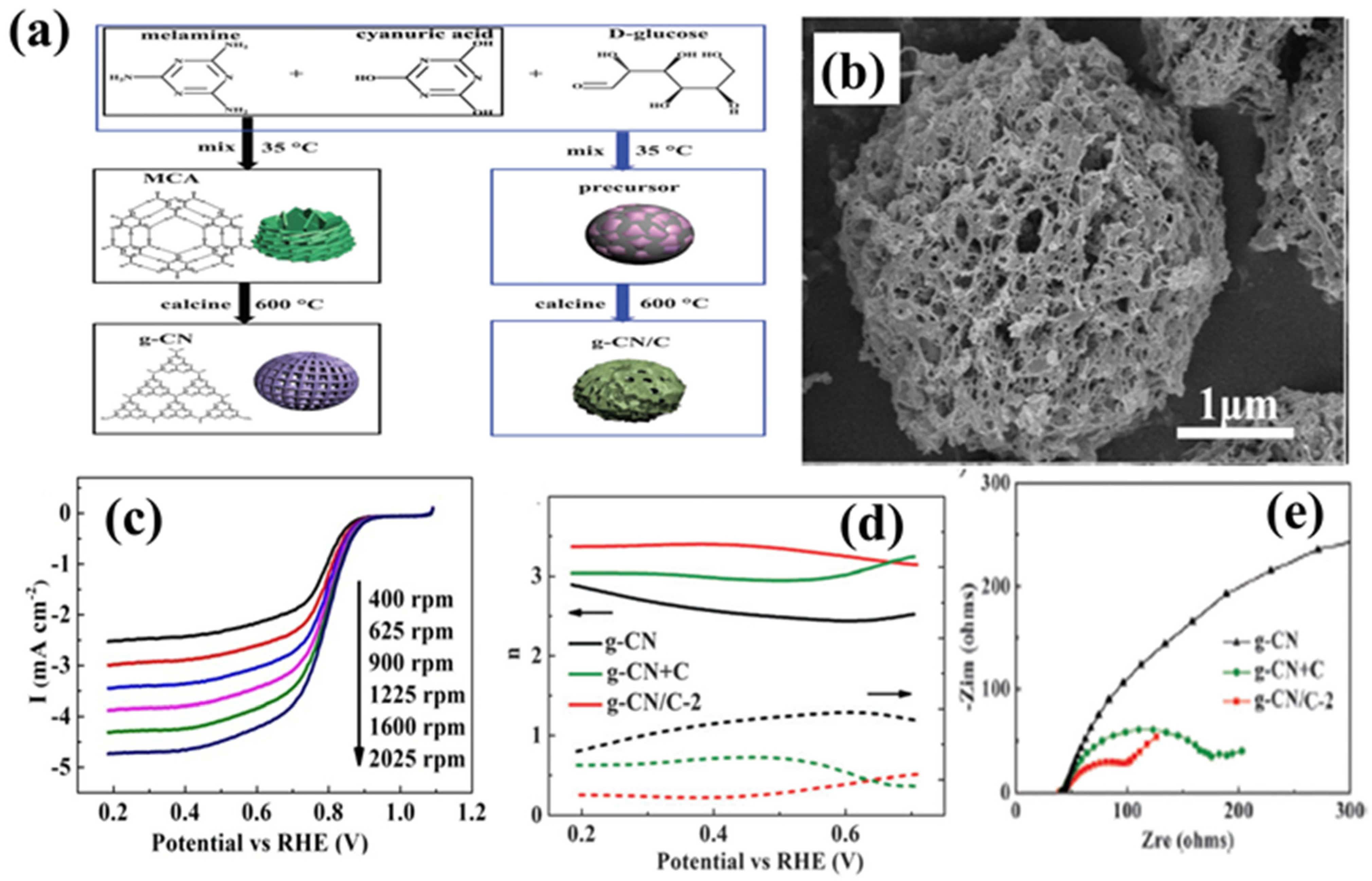

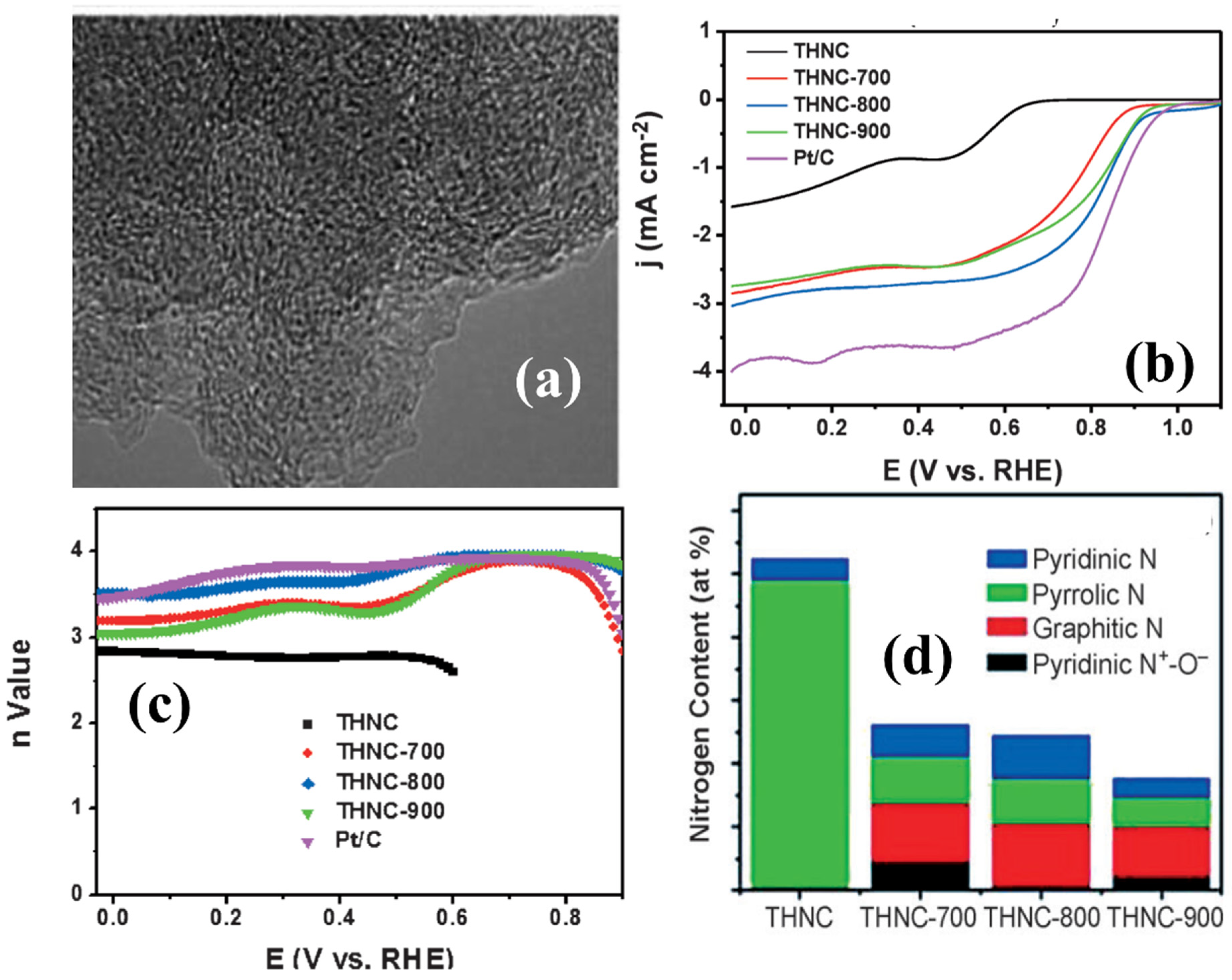

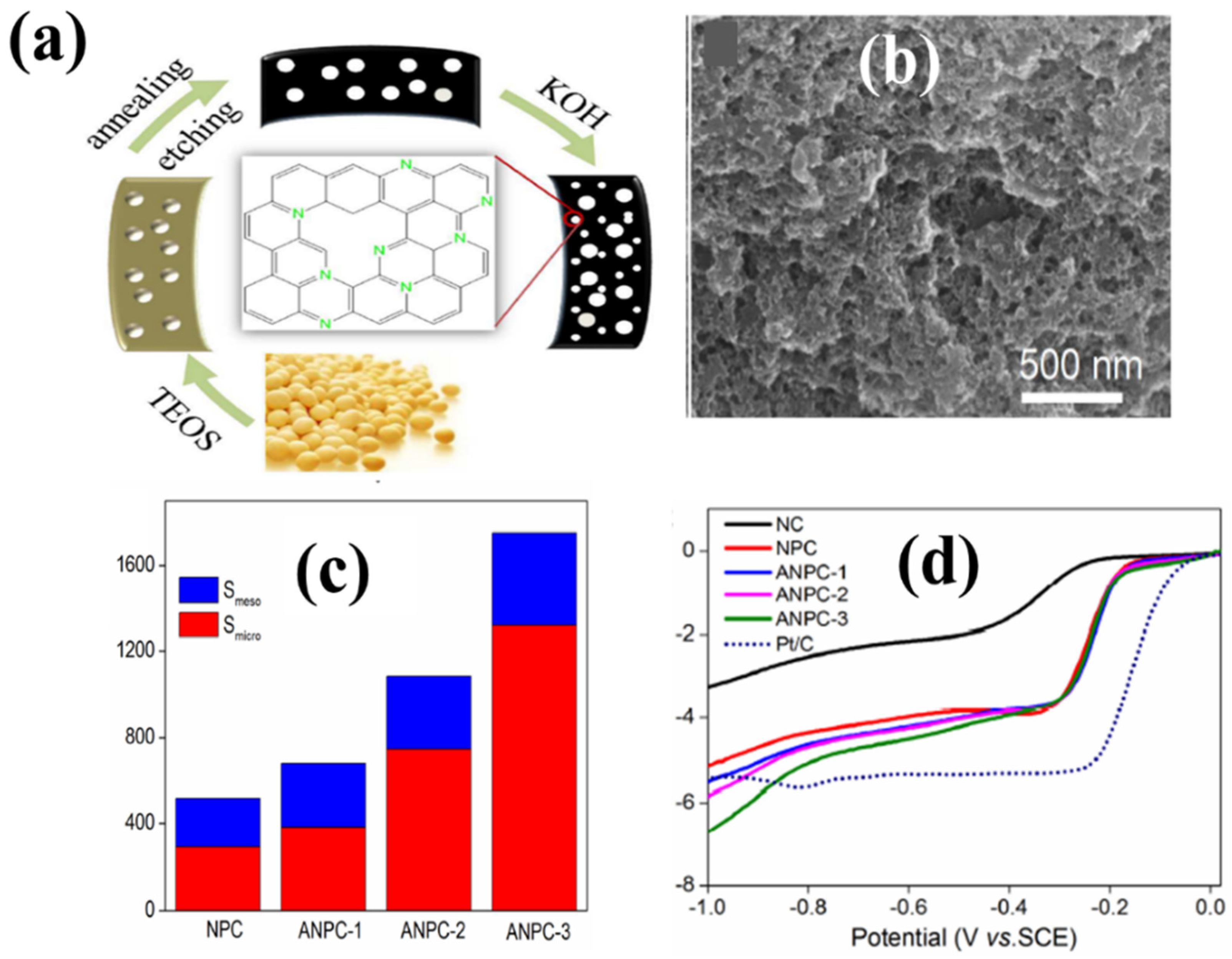

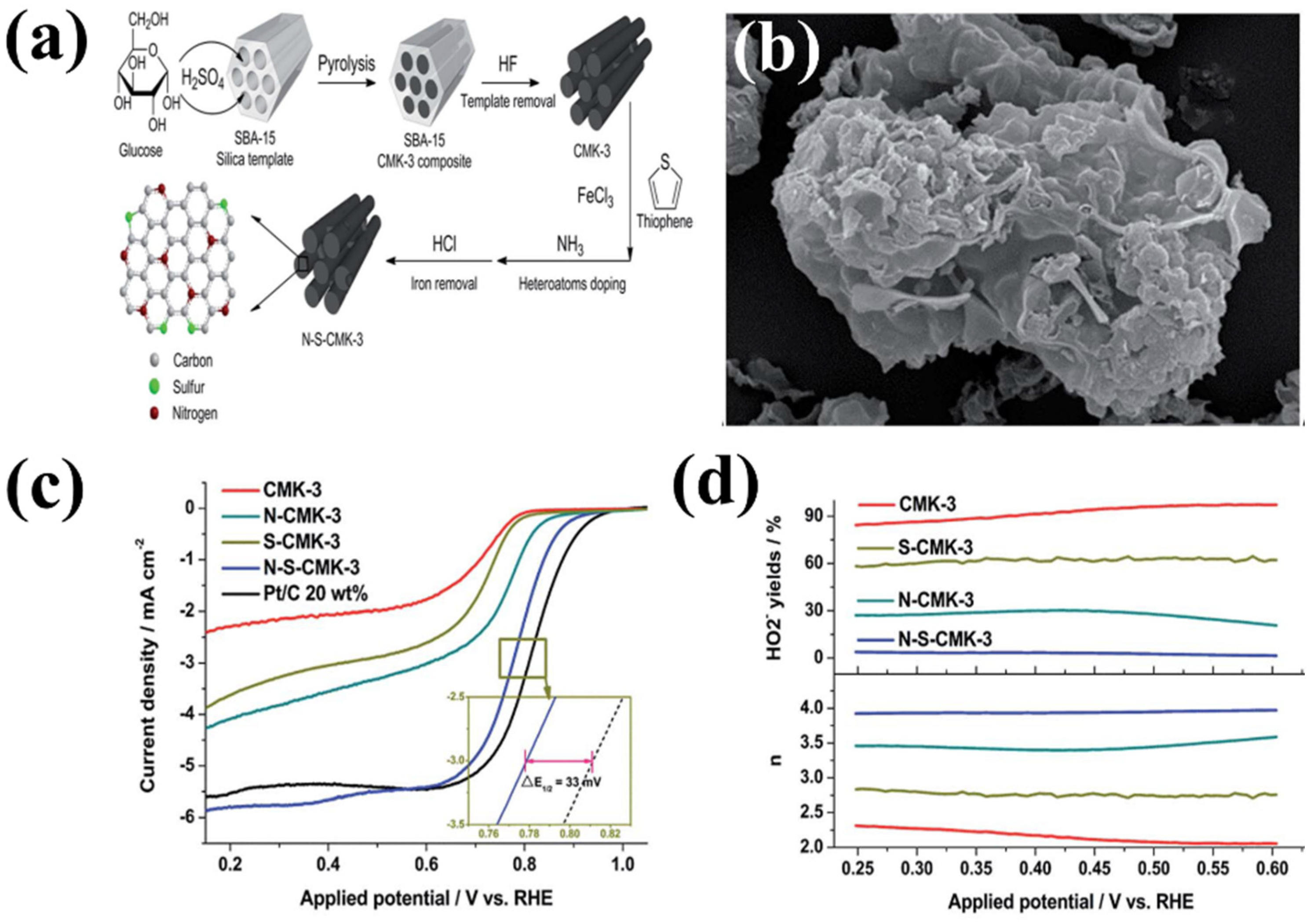
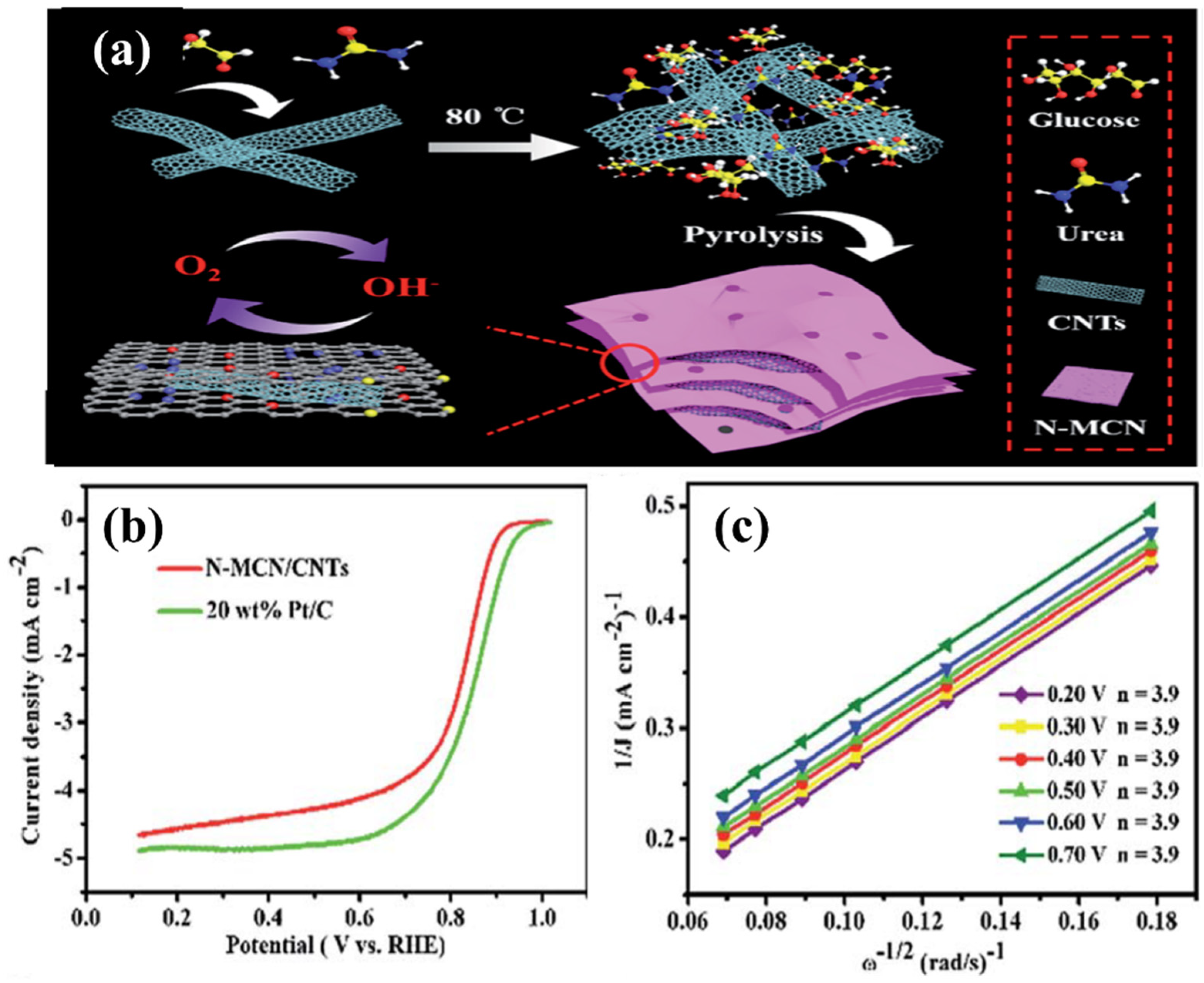
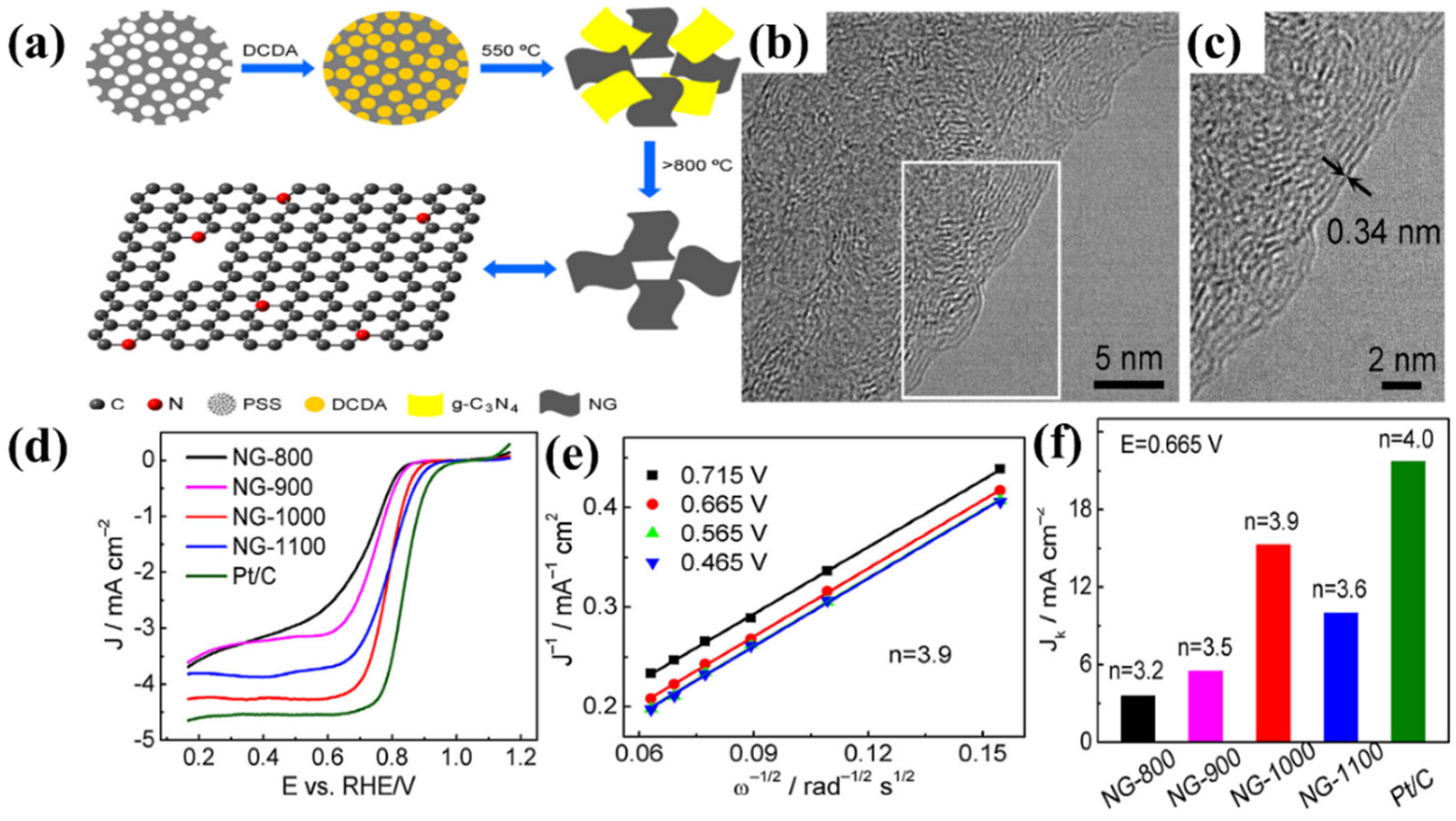


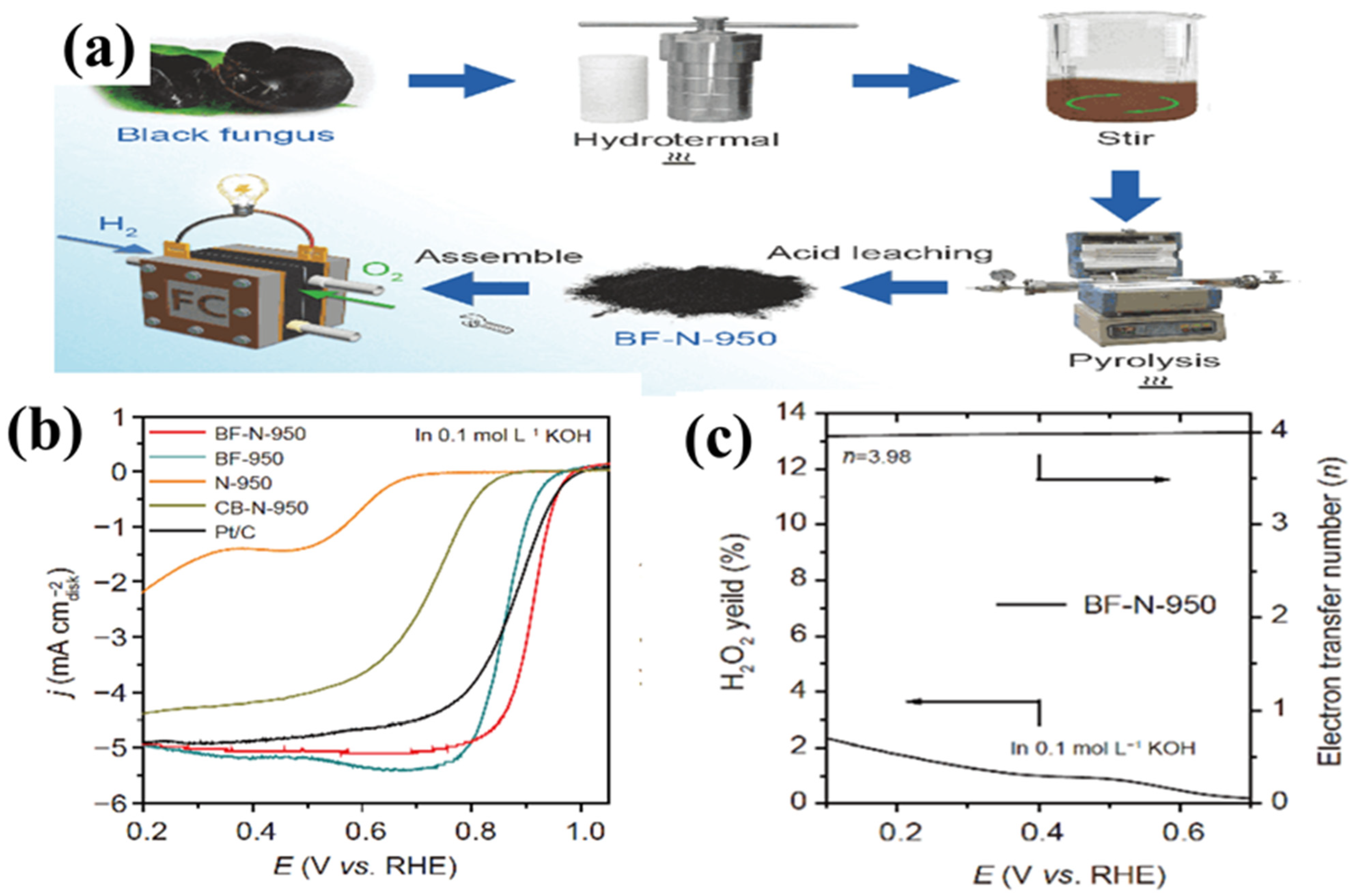
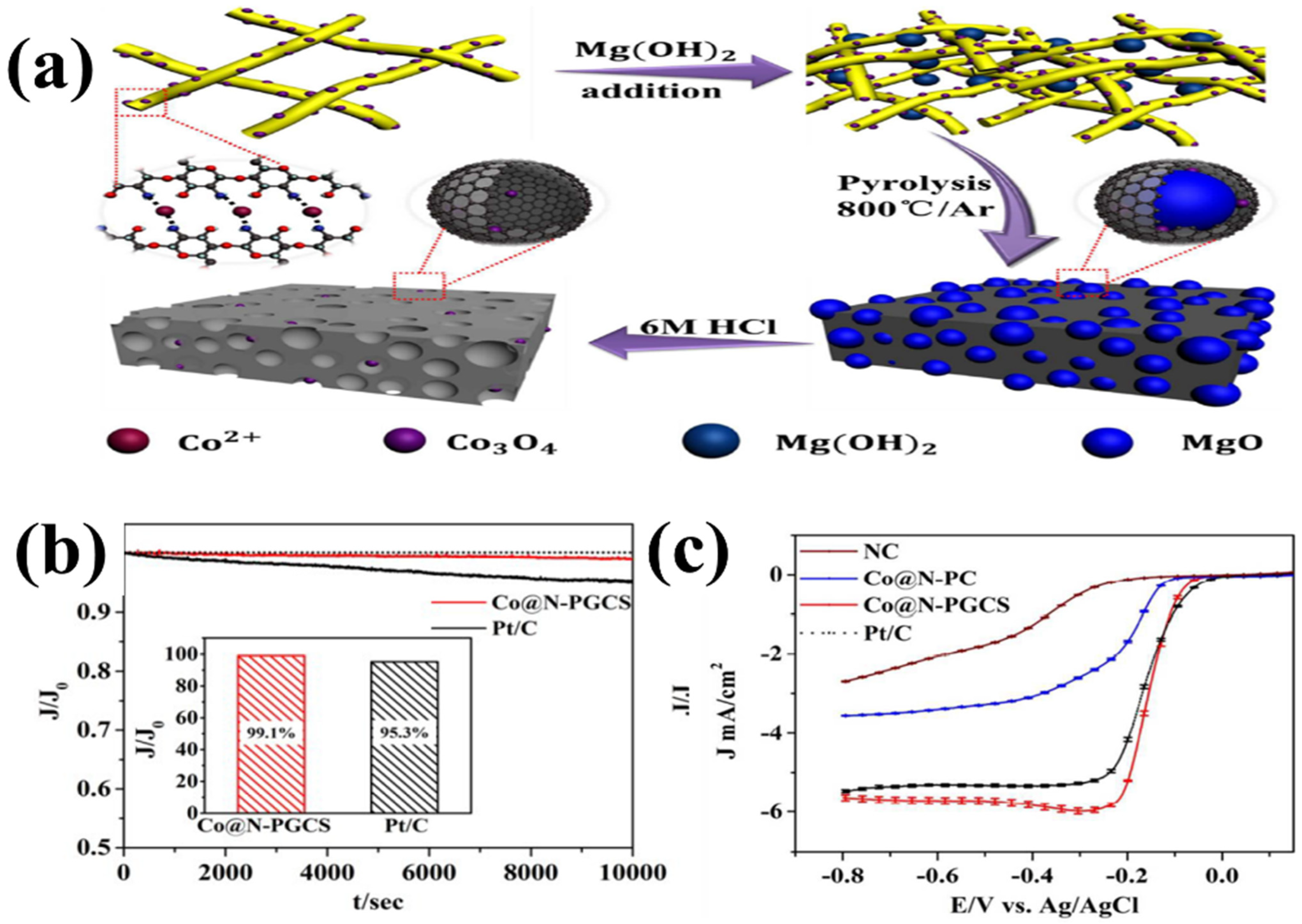
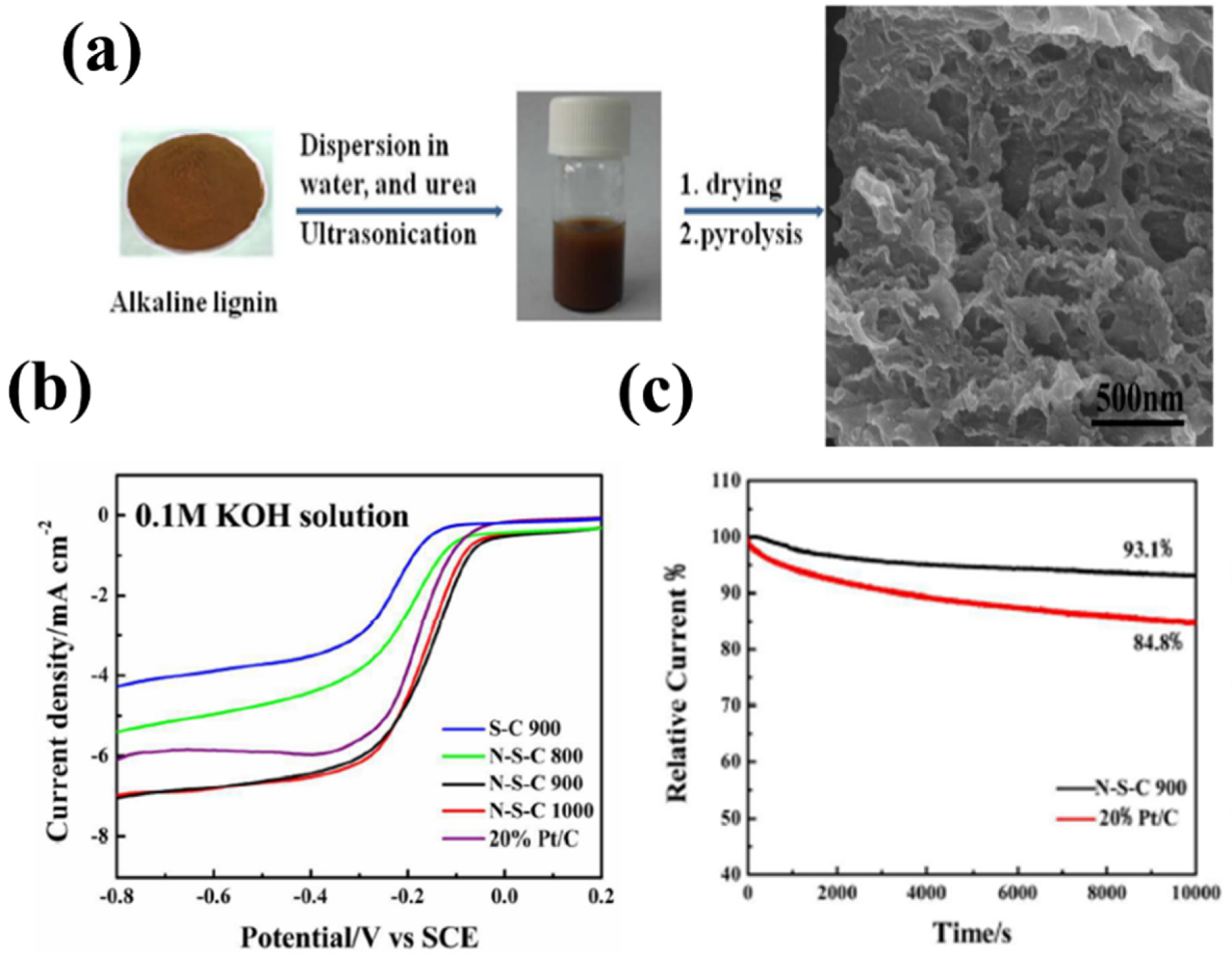
| Biomass Source | Activation Method | Surface Area [m2 g−1] | Eonset [V] vs. RHE | E1/2 [V] vs. RHE | JL [mA cm−2] | Transferred Electrons [n] | Ref. |
|---|---|---|---|---|---|---|---|
| Glucose | HTC, pyrolysis | 1036 | 0.92 | ---- | 3.0 | 3.5–3.9 | 51 |
| Glucose | Template-free, pyrolysis | 450 | 0.90 | 0.79 | 4.10 | ---- | 46 |
| Glucose | Hard templating, pyrolysis | 1023 | 0.92 | 0.73 | 5.50 | 3.96 | 61 |
| Glucose | Pyrolysis | 591.4 | 0.95 | 0.82 | 4.7 | 3.9 | 62 |
| Glucose | HTC, dual step pyrolysis | 1610.3 | 0.99 | 0.87 | 5.8 | 4.0 | 63 |
| Glucose | Dual template method | 1148 | 0.97 | 0.87 | 5.5 | ---- | 60 |
| Glucose | Pyrolysis | 610 | 0.95 | 0.81 | 5.7 | 3.88 | 64 |
| Glucose | HTC, pyrolysis | 398 | 0.89 | 0.76 | 4.9 | 3.95 | 65 |
| Glucose | Silica templating, dual step pyrolysis | 801.5 | 0.94 * | 0.87 | 5.1 * | 4.0 | 66 |
| Glucose | Soft templating, pyrolysis | 480.5 cm2 g−1 | 0.92 | 0.81 | 5.01 | 3.62 | 67 |
| Glucose | Dual templating, chemical activation | 1394 | 0.94 | 0.824 | 4.4 * | 3.20–3.97 | 68 |
| Glucose(Bean curd) | Dual step pyrolysis | 988.2 | 0.96 | 0.81 | 5.7 | 4.0 | 69 |
| Sucrose | Co impregnation, carbonization | 900 | 0.83 * | ---- | 2.55 | 2.9–4.0 * | 71 |
| Sucrose | HTC, pyrolysis | 528 | 0.88 | 0.74 | 5.6 | 3.72–3.9 | 72 |
| Sucrose | HTC, pyrolysis | ---- | 0.90 * | 0.79 | 4.3 * | 3.9 | 73 |
| Bamboo fungus | HTC, pyrolysis | 1895.5 | 1.08 | 0.92 | 3.5 | 3.6 | 18 |
| Seaweed | Pyrolysis | 1217 | 0.98 | 0.89 | 4.5 * | 3.7 | 74 |
| Okara | Pyrolysis | 517 | 1.00 | 0.89 | 4 | 3.5 | 75 |
| Grass | HTC, pyrolysis | ---- | 0.91 | ---- | 5.2 | 3.94 | 76 |
| Soybean shells | Carbonization, ammoxidation | 1152 | 0.98 | 0.78 | 5.24 | 3.8 | 48 |
| Eggplant | Activation, ammoxidation | 1969 | 0.95 | 0.65 | 5.5 | 3.87 | 77 |
| Coconut shells | Activation, pyrolysis | 1071 | 0.84 | ---- | 5.4 * | 3.7 | 78 |
| Alder wood | Pyrolysis, ball milling | 2245 | 0.92 | 0.85 | 5.9 | ---- | 79 |
| Spinach | Freeze-dry, double pyrolysis | 289.6 | 0.94 * | 0.88 | 5.8 * | 3.91 | 80 |
| Chitin | HTC, pyrolysis | 300.7 | 0.84 | 0.77 * | 4.5 | 3.87–3.99 | 82 |
| Chitin (Homarus americanus) | Pyrolysis | 188 | 0.80 * | ---- | ---- | 4 | 83 |
| Chitin | Carbonization | 76.18 | 0.80 | ---- | 4.64 | 3.65–3.87 | 84 |
| Chitin | Chemical activation, pyrolysis | ---- | 0.97 | ---- | 3.4 * | 3.84 | 85 |
| Chitin | HTC, pyrolysis | 916 | 0.98 * | 0.91 | 4.9 * | 3.9 | 86 |
| Chitosan | Pyrolysis | 220 | 0.95 | 0.88 | 5.36 | ---- | 89 |
| Chitosan | Hard templating, pyrolysis | 1716 | 0.92 | 0.84 | 5.5 * | 3.97 | 90 |
| Chitosan | Double pyrolysis | 416.7 | 0.94 | 0.90 | 3.58 | 3.2 | 91 |
| Chitosan | Silica template method | 873 | 0.92 | 0.82 | 3.3 | 3 | 92 |
| Chitosan | Pyrolysis | 337 | 0.91 | 0.82 * | 6.92 | 3.25 | 93 |
| Lignin | Pyrolysis | 1209 | 0.97 | 0.87 | 6.9 | 3.8 | 95 |
Publisher’s Note: MDPI stays neutral with regard to jurisdictional claims in published maps and institutional affiliations. |
© 2022 by the authors. Licensee MDPI, Basel, Switzerland. This article is an open access article distributed under the terms and conditions of the Creative Commons Attribution (CC BY) license (https://creativecommons.org/licenses/by/4.0/).
Share and Cite
Das, S.; Ghosh, S.; Kuila, T.; Murmu, N.C.; Kundu, A. Biomass-Derived Advanced Carbon-Based Electrocatalysts for Oxygen Reduction Reaction. Biomass 2022, 2, 155-177. https://doi.org/10.3390/biomass2030010
Das S, Ghosh S, Kuila T, Murmu NC, Kundu A. Biomass-Derived Advanced Carbon-Based Electrocatalysts for Oxygen Reduction Reaction. Biomass. 2022; 2(3):155-177. https://doi.org/10.3390/biomass2030010
Chicago/Turabian StyleDas, Srijib, Souvik Ghosh, Tapas Kuila, Naresh Chandra Murmu, and Aniruddha Kundu. 2022. "Biomass-Derived Advanced Carbon-Based Electrocatalysts for Oxygen Reduction Reaction" Biomass 2, no. 3: 155-177. https://doi.org/10.3390/biomass2030010
APA StyleDas, S., Ghosh, S., Kuila, T., Murmu, N. C., & Kundu, A. (2022). Biomass-Derived Advanced Carbon-Based Electrocatalysts for Oxygen Reduction Reaction. Biomass, 2(3), 155-177. https://doi.org/10.3390/biomass2030010






